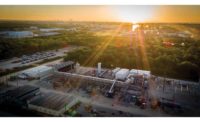Carbon Capture With Beneficial Conversion Is Focus of Prize
As pressure mounts on coal-and natural-gas-fired power plants—as well as cement kilns—to reduce CO2 emissions, researchers are looking to not only capture and store those emissions but also to convert CO2 into marketable products.
Construction of a $20-million Integrated Test Center for such research broke ground in May at the Basin Electric Power Cooperative’s Dry Fork Station, Wyoming. It is to be a demonstration facility to let up to five teams simultaneously test the commercial viability of processes to convert CO2 into high-value products, ranging from biofuels, to carbon fibers and construction materials. The facility will have five 23,000-sq-ft bays; there, processes will be run using coal-based flue gas from a co-located power plant.
Jason Begger, director of the Wyoming Infrastructure Authority, which will oversee the ITC, says that many technical teams around the world are working on CO2 conversion technologies in a laboratory setting, but very few are able to work at commercial-scale. “We really need to test these at a commercial scale” to determine their viability, Begger says.
The project is moving forward as a way to keep coal a viable option at a time when global efforts are underway to reduce carbon emissions. “We view coal as an important resource for the energy security of this country,” for the foreseeable future, says Dan Walsh, a senior program manager with the National Rural Electrical Cooperative Association, which kicked in $1 million for the construction of the ITC.
The Wyoming Infrastructure Authority is leasing the bays to the NRG COSIA Carbon XPRIZE, a global competition launched by the XPRIZE Foundation. The NRG and COSIA are sponsoring the foundation's four-and-a-half-year-long competition to award $20 million to the team that develops and demonstrates a process that captures the most CO2-- from either the ITC or a natural gas plant in Alberta--and then converts it into a high-value product—with a sustainable business model. Ten proposal finalists will be selected for the trials. Registration deadline is July 15.
Marcius Extavour, director of technical operations for the Carbon XPRIZE, says the goal is not just to find one winner but to develop “a suite of technologies” for future development.
Some of the research is looking at using a process modeled after natural photosynthesis to develop a oil that can be refined into a fuel. “Photosynthesis is the original carbon capture and conversion process on Earth,” Extavour says. But natural photosynthesis is not an energy-efficient process when looked at for possible use at commercial scale, he explains.
Others are more interested in replicating the natural CO2 conversion process in a reactor that could be designed and manufactured. Still others are looking at altering the chemistry of CO2 itself to produce a new substance.
Although such technologies could be economically transformative, developing a process to produce a viable CO2 product has been difficult. “We know it can be done, but [whether it can] be done at facility scale is the big question,” says Extavour. “It’s a question of engineering, demonstration and, ultimately, the economics.”


